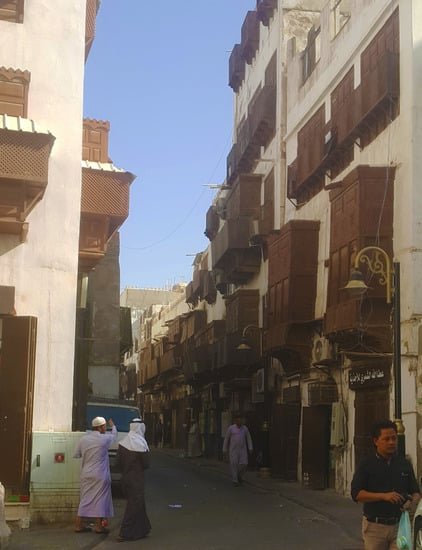Sustainable-Oriented Development for Urban Interface of Historic Centers
Abstract
:1. Introduction
1.1. Research Significance
1.2. Research Objectives
- Investigating the physical characteristics of urban areas, especially surrounding historical centers.
- Highlighting the urban morphology indices.
- Developing a framework that relates indices of urban morphology to sustainability aspects.
- Analyzing main urban features to identify physical characteristics that fulfill the socioeconomic and environmental requirements.
- Developing a set of design guides for the urban areas surrounding the historical centers within the MENA region.
1.3. Research Methodology
1.4. Sustainable Urban Fabric
1.5. Urban Morphology Classification
1.6. Impact of Urban Morphology on Urban Sustainability
1.6.1. Relation between Urban Morphology Indicators and Environmental Aspects
1.6.2. Relationship between Urban Morphology Indicators and Socioeconomic Aspects
1.7. Framework for Assessing Urban physical Indicators on Aspects of Sustainable Urban
2. Materials and Methods
2.1. Case Study
2.1.1. Jeddah Overview
2.1.2. Study Sites
3. Results and Discussion
4. Conclusions and Recommendations
- Plot divisions and building setback regulations that ensure permeable urban mass, allowing for free wind movement.
- Building regulations should maintain a gradual increase in building heights, starting at a low point next to the historic center to achieve a homogeneous skyline.
- New developments in surrounding areas’ open spaces need to be structured similarly to the outdoor spaces of the historic area, providing narrow shaded pedestrian dedicated paths to encourage vigorous outdoor social and economic activities.
- Matching and linking existing urban paths to the new development paths.
- While developing the area surrounding the historic center, consideration should be made to include services that serve the historic area and the new developments.
- Land use should benefit from the historic center as a commercial asset and complement the existing activities within the historic center.
Funding
Institutional Review Board Statement
Informed Consent Statement
Data Availability Statement
Conflicts of Interest
References
- Shehata, A.M. Current Trends in Urban Heritage Conservation: Medieval Historic Arab City Centers. Sustainability 2022, 14, 607. [Google Scholar] [CrossRef]
- Alraouf, A.A. Contemporary gulf cities’ urbanism: The dilemma of unsustainable developments and energy conservation. In The Political Economy of Energy Reform: The Clean Energy Fossil Fuel Balance In The Gulf States; Luciani, G., Ferroukhi, R., Eds.; Gerlach Press: Berlin, Germany, 2014; pp. 183–204, Chapter 7. [Google Scholar]
- Badawy, S.; Shehata, A.M. Sustainable urban heritage conservation strategies—A case study of historic Jeddah districts. In Cities’ Identity through Architecture and Arts; Catalani, A.Z.N., Versaci, A., Hawkes, D., Bougdah, H., Sotoca, A., Ghoneem, M., Trapani, F., Eds.; Taylor & Francis Group: London, UK, 2018; pp. 83–97. [Google Scholar] [CrossRef]
- Shehata, A.M.A.E.-R.; Mostafa, M.M.I. Open Museums as a Tool for Culture Sustainability. Procedia Environ. Sci. 2017, 37, 363–373. [Google Scholar] [CrossRef]
- Moubarak, L.M. The Egyptian city centers in the Islamic era: Image analysis, evaluation and contemporary reflection. J. Eng. Sci. Assiut Univ. 2020, 48, 538–553. [Google Scholar]
- Saad, T.R. Investigating the cultural landscape identity of Jeddah, KSA. WIT Trans. Built Environ. 2018, 177, 51–62. [Google Scholar]
- Fatani, K.A.; Mohamed, M.; Al-Khateeb, S. Survey Based Sustainable Socio-Cultural Guidelines for Neighborhood Design in Jeddah. IOP Conf. Ser. Earth Environ. Sci. 2019, 385, 012050. [Google Scholar] [CrossRef]
- Mandeli, K.N. The transformation of public spaces in Saudi cities a case study of Jeddah. In Proceedings of the Saudi International Conference, Coventry, UK, 26 June 2019. [Google Scholar] [CrossRef]
- Lai, D.; Liu, W.; Gan, T.; Liu, K.; Chen, Q. A review of mitigating strategies to improve the thermal environment and thermal comfort in urban outdoor spaces. Sci. Total. Environ. 2019, 661, 337–353. [Google Scholar] [CrossRef]
- Bai, X. Six research priorities for. Springer Nat. 2018, 555, 22–24. [Google Scholar]
- Boumans, R.J.; Phillips, D.L.; Victery, W.; Fontaine, T.D. Developing a model for effects of climate change on human health and health–environment interactions: Heat stress in Austin, Texas. Urban Clim. 2014, 8, 78–99. [Google Scholar] [CrossRef]
- Nikolopoulou, M.; Baker, N.; Steemers, K. Thermal comfort in outdoor urban spaces: Understanding the human parameter. Sol. Energy 2001, 70, 227–235. [Google Scholar] [CrossRef]
- United Nations Framework Convention on Climate Change. Yearbook of Global Climate Action 2021; United Nations Framework Convention on Climate Change: Bonn, Germany, 2021. [Google Scholar]
- Lefebvre, B.; Rodier, X.; Saligny, L. Understanding urban fabric with the oh_fet model based on social use, space and time. Archeol. Calc. 2008, 19, 195–214. [Google Scholar]
- Joan, P.; Giovanni, F.; Alessandro, A.; Fuse, A. Building typologies for urban fabric classification: Osaka and Marseille case studies. In Proceedings of the International Conference on Spatial Analysis and Modeling, Paris, UK, 17–18 May 2024. [Google Scholar]
- Newman, P.; Kosonen, L.; Kenworthy, J. Theory of urban fabrics: Planning the walking, transit/public transport and automobile/motor car cities for reduced car dependency. Town Plan. Rev. 2016, 87, 429–458. [Google Scholar] [CrossRef]
- Li, X.; Lv, Z.; Hijazi, I.H.; Jiao, H.; Li, L.; Li, K. Assessment of Urban Fabric for Smart Cities. IEEE Access 2016, 4, 373–382. [Google Scholar] [CrossRef]
- Ravari, A.A.; Mazloomi, M. A framework for urban morphology with respect to the form. Arman. Archit. Urban Dev. 2015, 8, 91–103. [Google Scholar]
- Yang, J.; Yang, Y.; Sun, D.; Jin, C.; Xiao, X. Influence of urban morphological characteristics on thermal environment. Sustain. Cities Soc. 2021, 72, 103045. [Google Scholar] [CrossRef]
- Chen, W.; Wu, A.N.; Biljecki, F. Classification of urban morphology with deep learning: Application on urban vitality. Comput. Environ. Urban Syst. 2021, 90, 101706. [Google Scholar] [CrossRef]
- Fatani, K.; Mohamed, M.; Al-Khateeb, S. Sustainable Socio-cultural Guidelines for Neighborhood Design in Jeddah. Procedia Environ. Sci. 2017, 37, 584–593. [Google Scholar] [CrossRef]
- Throsby, D.; Petetskaya, K. Heritage-led urban rehabilitation: Evaluation methods and an application in Jeddah, Saudi Arabia. City Cult. Soc. 2021, 26, 100397. [Google Scholar] [CrossRef]
- Potchter, O.; Cohen, P.; Lin, T.-P.; Matzarakis, A. Outdoor human thermal perception in various climates: A comprehensive review of approaches, methods and quantification. Sci. Total Environ. 2018, 631–632, 390–406. [Google Scholar] [CrossRef]
- Mauree, D.; Naboni, E.; Coccolo, S.; Perera, A.; Nik, V.M.; Scartezzini, J.-L. A review of assessment methods for the urban environment and its energy sustainability to guarantee climate adaptation of future cities. Renew. Sustain. Energy Rev. 2019, 112, 733–746. [Google Scholar] [CrossRef]
- Perini, K.; Calise, C.; Castellari, P.; Roccotiello, E. Microclimatic and Environmental Improvement in a Mediterranean City through the Regeneration of an Area with Nature-Based Solutions: A Case Study. Sustainability 2022, 14, 5847. [Google Scholar] [CrossRef]
- Luber, G.; McGeehin, M. Climate Change and Extreme Heat Events. Am. J. Prev. Med. 2008, 35, 429–435. [Google Scholar] [CrossRef]
- Li, J.; Mao, Y.; Ouyang, J.; Zheng, S. A Review of Urban Microclimate Research Based on CiteSpace and VOSviewer Analysis. Int. J. Environ. Res. Public Health 2022, 19, 4741. [Google Scholar] [CrossRef] [PubMed]
- Lai, D.; Lian, Z.; Liu, W.; Guo, C.; Liu, W.; Liu, K.; Chen, Q. A comprehensive review of thermal comfort studies in urban open spaces. Sci. Total. Environ. 2020, 742, 140092. [Google Scholar] [CrossRef]
- Lamarca, C.; Qüense, J.; Henríquez, C. Thermal comfort and urban canyons morphology in coastal temperate climate, Concepción, Chile. Urban Clim. 2018, 23, 159–172. [Google Scholar] [CrossRef]
- Canan, F.; Golasi, I.; Ciancio, V.; Coppi, M.; Salata, F. Outdoor thermal comfort conditions during summer in a cold semi-arid climate. A transversal field survey in Central Anatolia (Turkey). Build. Environ. 2018, 148, 212–224. [Google Scholar] [CrossRef]
- Ali, S.B.; Patnaik, S. Thermal comfort in urban open spaces: Objective assessment and subjective perception study in tropical city of Bhopal, India. Urban Clim. 2018, 24, 954–967. [Google Scholar] [CrossRef]
- Xu, X.; Yin, C.; Wang, W.; Xu, N.; Hong, T.; Li, Q. Revealing Urban Morphology and Outdoor Comfort through Genetic Algorithm-Driven Urban Block Design in Dry and Hot Regions of China. Sustainability 2019, 11, 3683. [Google Scholar] [CrossRef]
- Niu, J.; Liu, J.; Lee, T.-C.; Lin, Z.; Mak, C.; Tse, K.-T.; Tang, B.-S.; Kwok, K.C. A new method to assess spatial variations of outdoor thermal comfort: Onsite monitoring results and implications for precinct planning. Build. Environ. 2015, 91, 263–270. [Google Scholar] [CrossRef]
- Raman, V.; Kumar, M.; Sharma, A.; Froehlich, D.; Matzarakis, A. Quantification of thermal stress abatement by trees, its dependence on morphology and wind: A case study at Patna, Bihar, India. Urban For. Urban Green. 2021, 63, 127213. [Google Scholar] [CrossRef]
- Tsoka, S.; Tsikaloudaki, K.; Theodosiou, T. Urban space’s morphology and microclimatic analysis: A study for a typical urban district in the Mediterranean city of Thessaloniki, Greece. Energy Build. 2017, 156, 96–108. [Google Scholar] [CrossRef]
- Nasrollahi, N.; Hatami, Z.; Taleghani, M. Development of outdoor thermal comfort model for tourists in urban historical areas; A case study in Isfahan. Build. Environ. 2017, 125, 356–372. [Google Scholar] [CrossRef]
- Johansson, E.; Emmanuel, R. The influence of urban design on outdoor thermal comfort in the hot, humid city of Colombo, Sri Lanka. Int. J. Biometeorol. 2006, 51, 119–133. [Google Scholar] [CrossRef]
- Berardi, U.; Wang, Y. The Effect of a Denser City over the Urban Microclimate: The Case of Toronto. Sustainability 2016, 8, 822. [Google Scholar] [CrossRef]
- Chatzidimitriou, A.; Yannas, S. Microclimate design for open spaces: Ranking urban design effects on pedestrian thermal comfort in summer. Sustain. Cities Soc. 2016, 26, 27–47. [Google Scholar] [CrossRef]
- Chen, L.; Ng, E.; An, X.; Ren, C.; Lee, M.; Wang, U.; He, Z. Sky view factor analysis of street canyons and its implications for daytime intra-urban air temperature differentials in high-rise, high-density urban areas of Hong Kong: A GIS-based simulation approach. Int. J. Clim. 2010, 32, 121–136. [Google Scholar] [CrossRef]
- Coutts, A.M.; Beringer, J.; Tapper, N.J. Investigating the climatic impact of urban planning strategies through the use of regional climate modelling: A case study for Melbourne, Australia. Int. J. Clim. 2008, 28, 1943–1957. [Google Scholar] [CrossRef]
- Ali-Toudert, F.; Djenane, M.; Bensalem, R.; Mayer, H. Outdoor thermal comfort in the old desert city of Beni-Isguen, Algeria. Clim. Res. 2005, 28, 243–256. [Google Scholar] [CrossRef]
- Shih, W.-M.; Lin, T.-P.; Tan, N.-X.; Liu, M.-H. Long-term perceptions of outdoor thermal environments in an elementary school in a hot-humid climate. Int. J. Biometeorol. 2017, 61, 1657–1666. [Google Scholar] [CrossRef]
- Chen, H.-C.; Han, Q.; de Vries, B. Urban morphology indicator analyzes for urban energy modeling. Sustain. Cities Soc. 2020, 52, 101863. [Google Scholar] [CrossRef]
- Cai, C.; Guo, Z.; Zhang, B.; Wang, X.; Li, B.; Tang, P. Urban Morphological Feature Extraction and Multi-Dimensional Similarity Analysis Based on Deep Learning Approaches. Sustainability 2021, 13, 6859. [Google Scholar] [CrossRef]
- Aina, Y.A.; Al-Naser, A.; Garb, S.B. Towards an integrative theory approach to sustainable urban design in Saudi Arabia: The value of geodesign. In Advances in Landscape Architecture; IntechOpen: London, UK, 2013; Chapter 20. [Google Scholar]
- Mohamed, F.M.; Khateeb, S.E. An analytical study of the impact of streetscape in Jeddah on social behavior of the users. In Proceedings of the International Conference on Agricultural, Civil and Environmental Engineering (ACEE-16), Istanbul, Turkey, 18–19 April 2016; pp. 26–31. [Google Scholar] [CrossRef]
- Biljecki, F.; Chow, Y.S. Global Building Morphology Indicators. Comput. Environ. Urban Syst. 2022, 95, 101809. [Google Scholar] [CrossRef]
- Lee, K.; Levermore, G. The variation of sky factor from urban geometry. In Proceedings of the 9th International Conference on Urban Climate jointly with 12th Symposium on the Urban Environment, Toulouse, France, 20–24 July 2015. [Google Scholar]
- Jeddah Annual Report 2016–2017; Jeddah Champer: Jeddah, Saudi Arabia, 2018.
- Masoud, B.; Coch, H.; Beckers, B. The correlation between urban morphology parameters and incident solar radiation performance to enhance pedestrian comfort, case study Jeddah, Saudi Arabia. In Sustainability in Energy and Buildings; Springer Nature Singapore Pte Ltd.: Singapore, 2020; pp. 543–554, Chapter 46. [Google Scholar]
- Affairs, M.O.M. Jeddah City Profile; United Nations Human Settlements Program (UN-Habitat): Jeddah, Arabia, 2019. [Google Scholar]
- Abdulaal, W.A. Large urban developments as the new driver for land development in Jeddah. Habitat Int. 2012, 36, 36–46. [Google Scholar] [CrossRef]
- Abdulgani, K. Jeddah. Cities 1993, 10, 50–59. [Google Scholar] [CrossRef]
- Shawly, H. Evaluating Compact City Model Implementation as a Sustainable Urban Development Tool to Control Urban Sprawl in the City of Jeddah. Sustainability 2022, 14, 13218. [Google Scholar] [CrossRef]
- Vasilikou, C.; Nikolopoulou, M. Outdoor thermal comfort for pedestrians in movement: Thermal walks in complex urban morphology. Int. J. Biometeorol. 2020, 64, 277–291. [Google Scholar] [CrossRef]
- Lisaia, D.; Zhang, C. Morphological and physical characteristics of the historic urban fabric and traditional streets of Xiguan in Guangzhou. J. Urban Des. 2022, 27, 441–458. [Google Scholar] [CrossRef]
- Bagader, M.A. The sustainable investment in urban heritage sites: Local, regional and international models. J. Umm Al-Qura Univ. Eng. Archit. 2021, 12, 1–7. [Google Scholar]
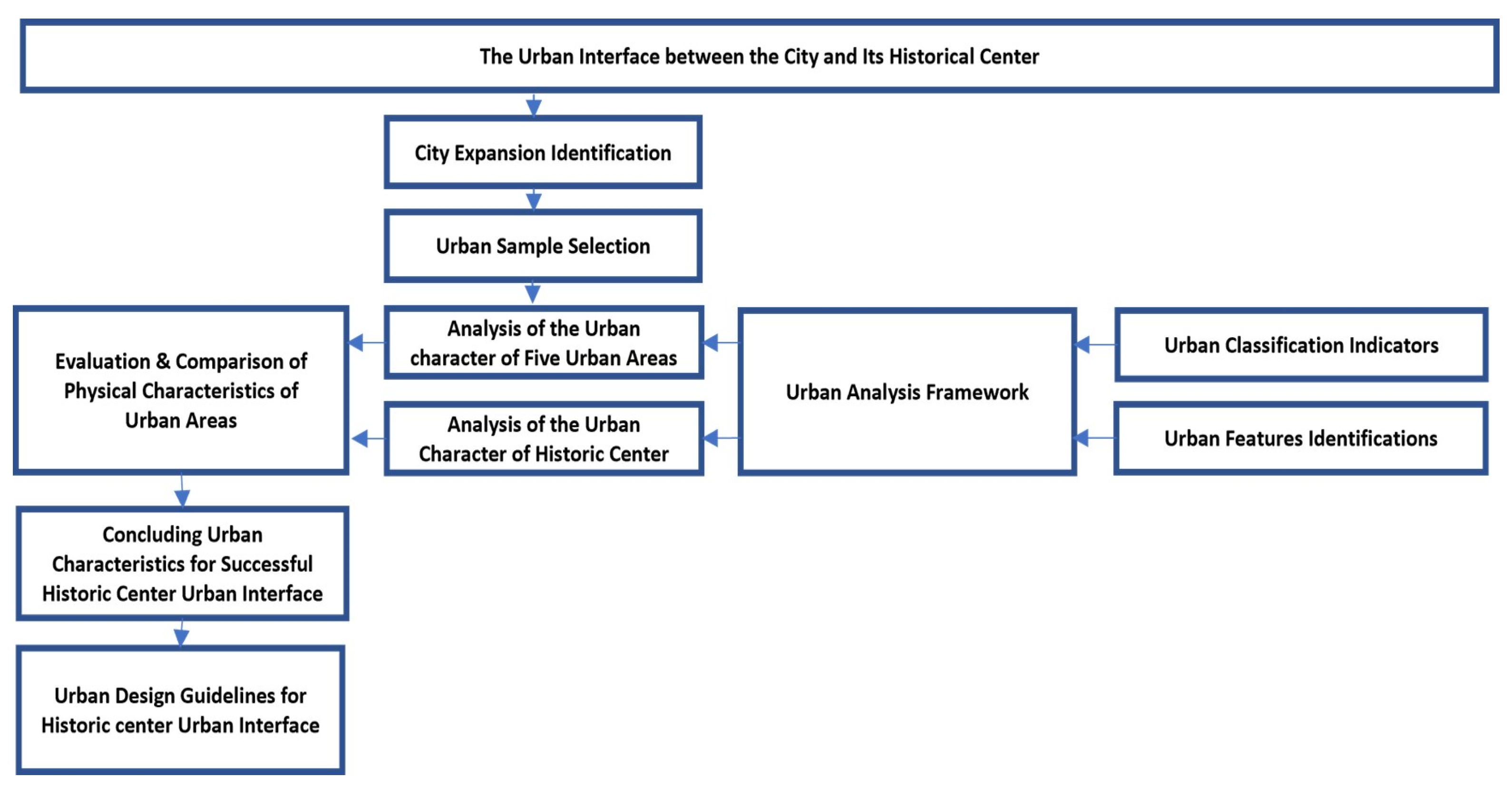

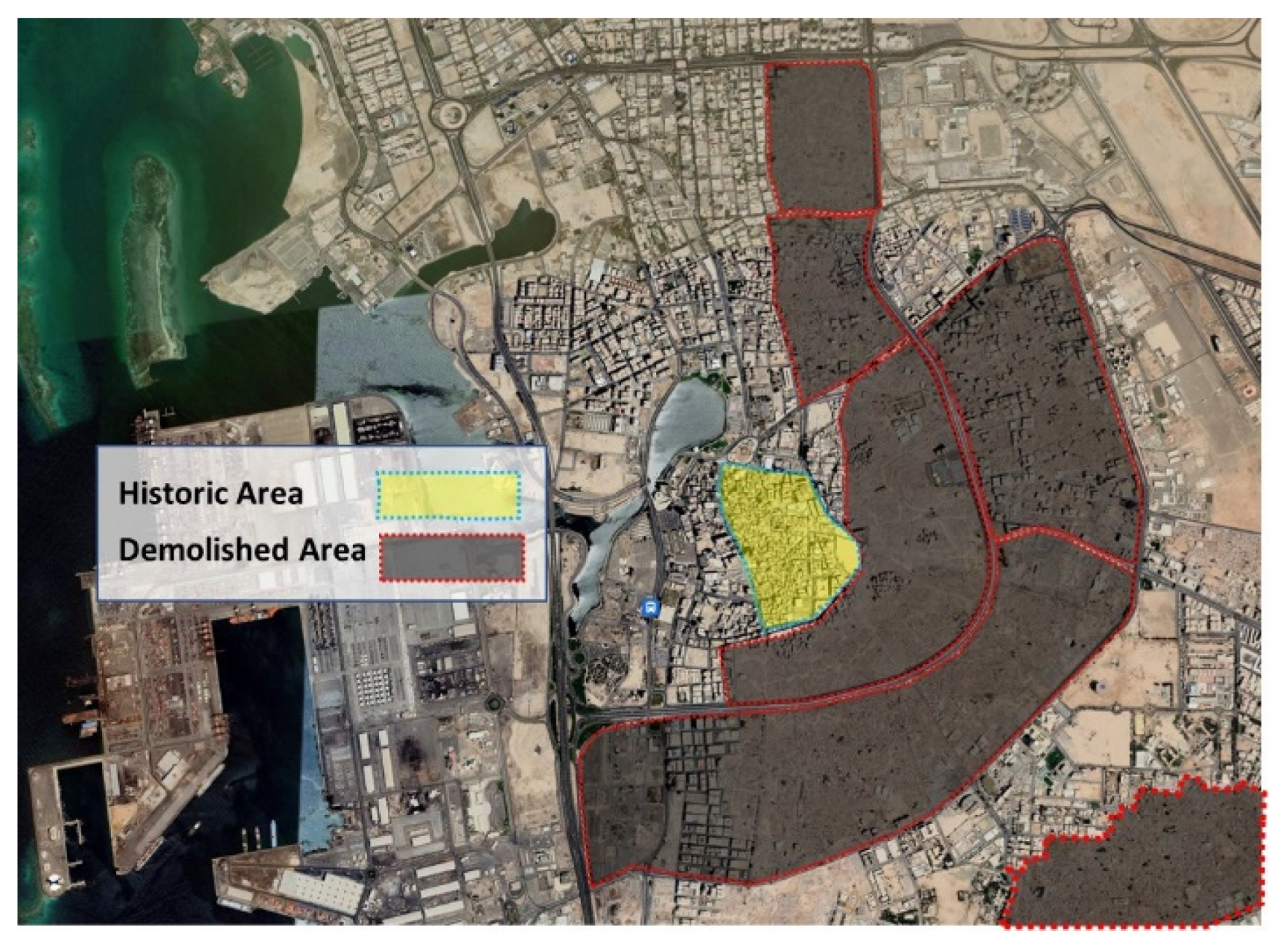
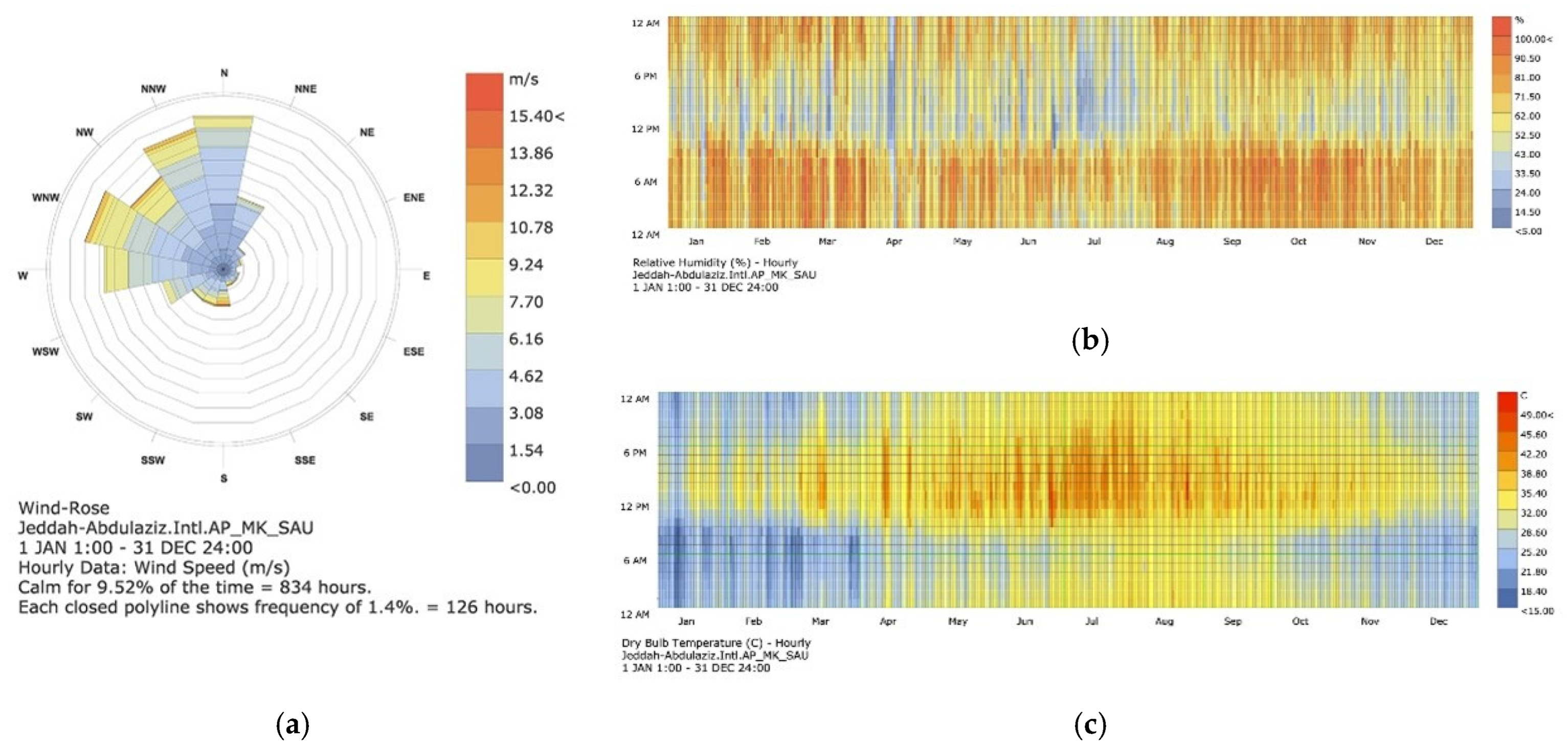

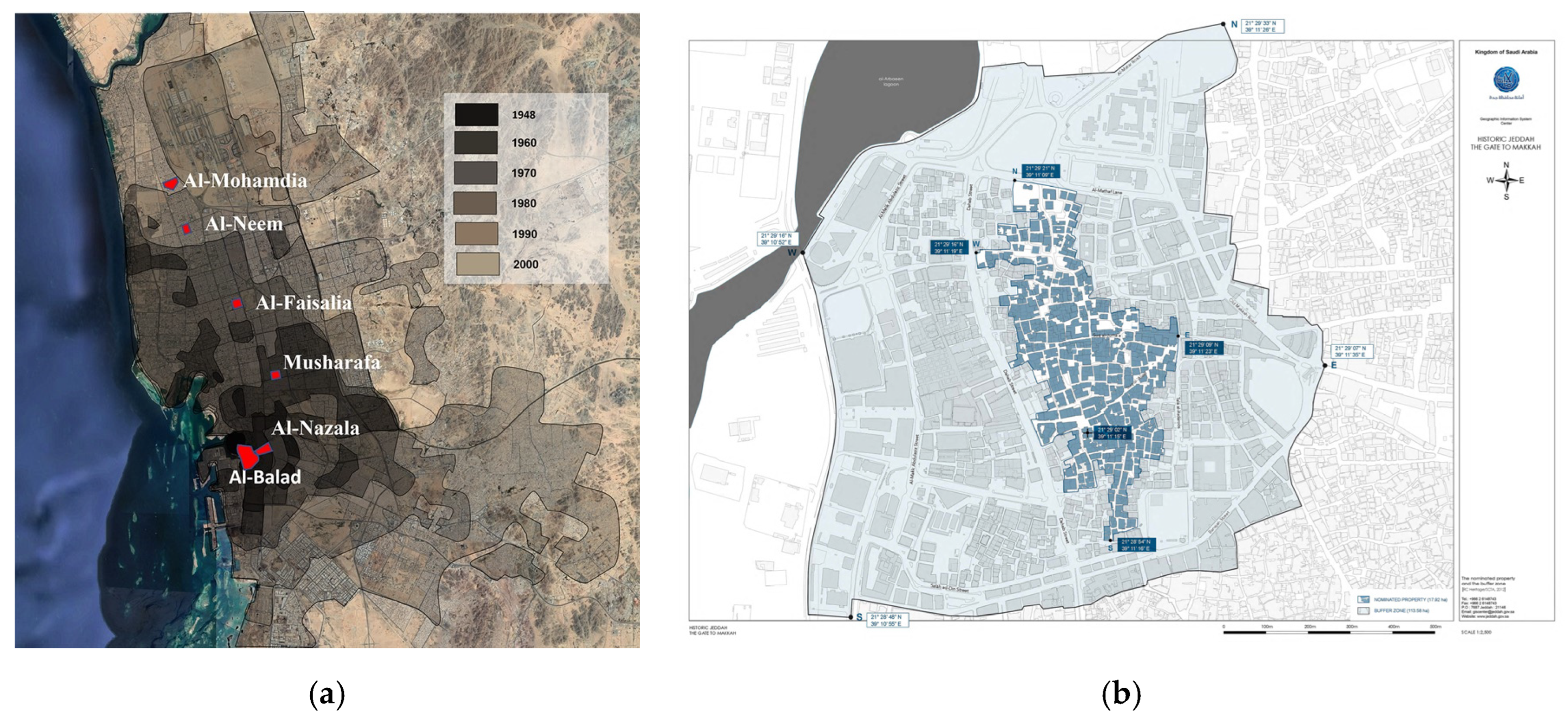
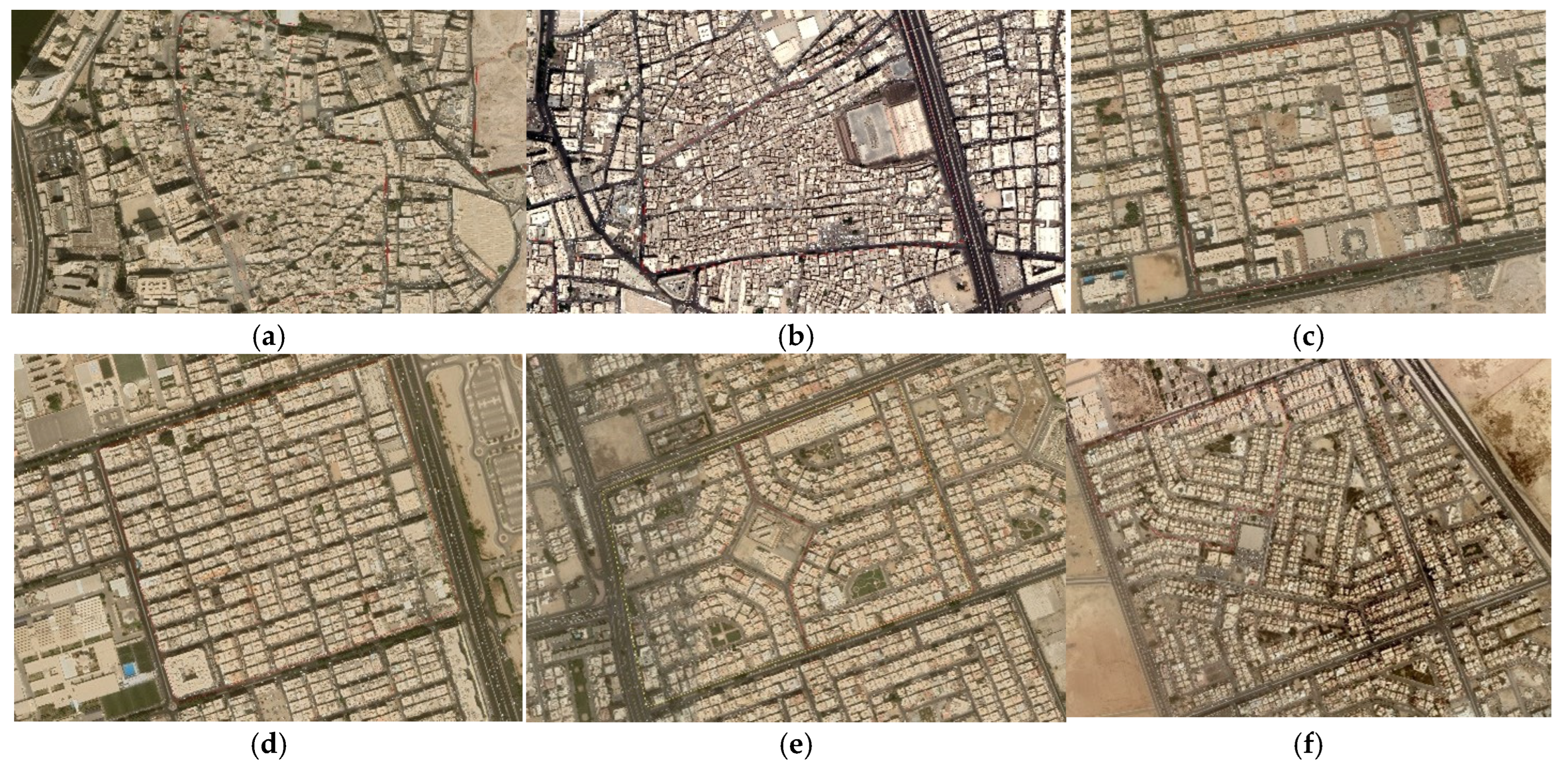
| Environment Aspects | Socioeconomic Aspects | ||||||||||
|---|---|---|---|---|---|---|---|---|---|---|---|
| Air Temperature | Wind | Humidity | Privacy | Proximity | Safety/Security | Community/Sense of Belonging | Prosperity Values | Green Economy | Energy Consumption | ||
| Plots | Plot Area | ||||||||||
| Plot Ratio (PR) | |||||||||||
| Plots Areas Percentage | |||||||||||
| Construction Ratio (CR) | |||||||||||
| Buildings | Frontal Area Index (FAI) | ||||||||||
| Floor Area Ratio (FAR) | |||||||||||
| Building Height | |||||||||||
| Mean Aspect Ratio (λc) | |||||||||||
| Paths | Path coverage area | ||||||||||
| Path Average Length | |||||||||||
| Paths Area Percent | |||||||||||
| Main Paths Orientation | |||||||||||
| Urban Mass Permeability | Void Percentage | ||||||||||
| Average Path Width | |||||||||||
| Absolute Rugosity (Ra) | |||||||||||
| Sky View Factor | |||||||||||
| Weak Impact | Moderate Impact | Strong Impact | |||||||||
| Indicator | Index | Description | Equation | |
|---|---|---|---|---|
| Plots | Average Plot Area | The average area of plots. | Pa | |
| Plot Ratios (PR) | The ratio between the depth and width of the plot. | PR | ||
| Construction Ratio (CR) | The allowed construction area to the plot area. | (1) | ||
| where Aij is the built area of the ij building, and S is the total plot area. | ||||
| Plots Areas Percentage (Pa) | The ratio between total plot areas and site area. | (2) | ||
| where Pa is the plot area, Pn is the number of plots, and Sa is the site area. | ||||
| Buildings | Frontal Area Index ey(λf) | The total areas of the building’s vertical surfaces facing the wind direction are divided by the building area. | λf = Afacets/Aplane | (3) |
| where λf is the frontal area index, Afacets is the total areas of building vertical surfaces facing the wind direction, and Aplane is the building area. | ||||
| Floor Area Ratio (FAR): | It represents the building density. It can be calculated through the following formula: the ratio of the built-up area to the overall plot area. [19,32] | (4) | ||
| where Ai is the total building floor area, and S is the plot area. | ||||
| Building Height | Average building heights. | (5) | ||
| where W is the average plot width, H is the average building height, and Np is the number of plots. | ||||
| Mean Aspect Ratio (λc): | The ratio between the building envelope area and the footprint area. | (6) | ||
| where (Ei) is the building envelope area of the ith building, and S is the total plot area. | ||||
| Paths | Path Coverage Area | The total site area is divided by the number of paths. | Pc = Sa/Pn | (7) |
| Road Average Length | Average main paths length. | RL | ||
| Paths Area Percent | Total roads area percent of the site area. | (8) | ||
| where Bh is the total road area, and Sa is the site area. | ||||
| Main Paths Orientation | The direction of the main paths in angles. | OR | ||
| Urban Mass Permeability | Void Percentage | Percentage of unbuilt areas of the test site. | (9) | |
| where FP is the average building footprint, Pn is the Building Numbers, and Sa is the site area. | ||||
| Average Width | The average width of paths. | Pw | ||
| Absolute Rugosity (AR): | The average height of obstacles that resist the wind over the urban area. | (10) | ||
| where Ni is the average building’s floor number, and ΔH is the average building height. | ||||
| Sky View Factor: | The ratio of the received radiation on the ground surface to the total received radiation by the entire hemisphere [19]. | (11) | ||
| where n = 360/α | ||||
| Al-Balad | Al-Nazala | Mushrafa | Al-Faisalia | Al-Neem | Mohamdia | ||
|---|---|---|---|---|---|---|---|
| 1948 | 1960 | 1970 | 1980 | 1990 | 2000 | ||
| Plot | Total Site area | 169,010 | 249,799 | 251,992 | 334,745 | 235,053 | 278,352 |
| Plot Numbers | 785 | 925 | 189 | 416 | 191 | 330 | |
| Plot Area | 148.2 | 194 | 840 | 506 | 675 | 504 | |
| Plot Ratio (PR) | 1 | 1 | 0.93 | 0.96 | 0.93 | 0.88 | |
| Plots Areas Percentage | 69% | 72% | 63% | 63% | 55% | 60% | |
| Construction Ratio (CR) | 1 | 1 | 0.8 | 0.8 | 0.6 | 0.6 | |
| Buildings | Frontal Area Index (FAI) | 0.88 | 0.6 | 0.2 | 0.32 | 0.15 | 0.27 |
| Floor Area Ratio (FAR) | 1 | 1 | 0.8 | 0.76 | 0.64 | 0.57 | |
| Building Height | 10.88 | 9.67 | 14.27 | 13.48 | 8.35 | 11.43 | |
| Mean Aspect Ratio (λc) | 1.93 | 3.05 | 3.37 | 2.84 | 2.48 | 3.69 | |
| Paths | Path coverage area | 4829 | 3785 | 22,908 | 15,940 | 47,011 | 39,765 |
| Path Average Length | 244.9 | 225 | 204 | 249 | 210 | 413 | |
| Paths Area Percent | 35% | 31% | 12% | 31% | 18% | 15% | |
| Main Paths Orientation | irregular east to west | Irregular East/West | North | North | North--West | North--West | |
| Urban Mass Permeability | Void Percentage | 31% | 29% | 51% | 49% | 53% | 48% |
| Average Path Width | 7.2 | 5.2 | 15 | 16 | 22 | 24 | |
| Absolute Rugosity (Ra) | 0.7 | 1.74 | 1.61 | 1.94 | 1.69 | 1.93 | |
| Sky View Factor | 0.37 | 0.46 | 0.42 | 0.45 | 0.6 | 0.64 | |
Disclaimer/Publisher’s Note: The statements, opinions and data contained in all publications are solely those of the individual author(s) and contributor(s) and not of MDPI and/or the editor(s). MDPI and/or the editor(s) disclaim responsibility for any injury to people or property resulting from any ideas, methods, instructions or products referred to in the content. |
© 2023 by the author. Licensee MDPI, Basel, Switzerland. This article is an open access article distributed under the terms and conditions of the Creative Commons Attribution (CC BY) license (https://creativecommons.org/licenses/by/4.0/).
Share and Cite
Shehata, A.M. Sustainable-Oriented Development for Urban Interface of Historic Centers. Sustainability 2023, 15, 2792. https://doi.org/10.3390/su15032792
Shehata AM. Sustainable-Oriented Development for Urban Interface of Historic Centers. Sustainability. 2023; 15(3):2792. https://doi.org/10.3390/su15032792
Chicago/Turabian StyleShehata, Ahmed Mohamed. 2023. "Sustainable-Oriented Development for Urban Interface of Historic Centers" Sustainability 15, no. 3: 2792. https://doi.org/10.3390/su15032792
APA StyleShehata, A. M. (2023). Sustainable-Oriented Development for Urban Interface of Historic Centers. Sustainability, 15(3), 2792. https://doi.org/10.3390/su15032792







